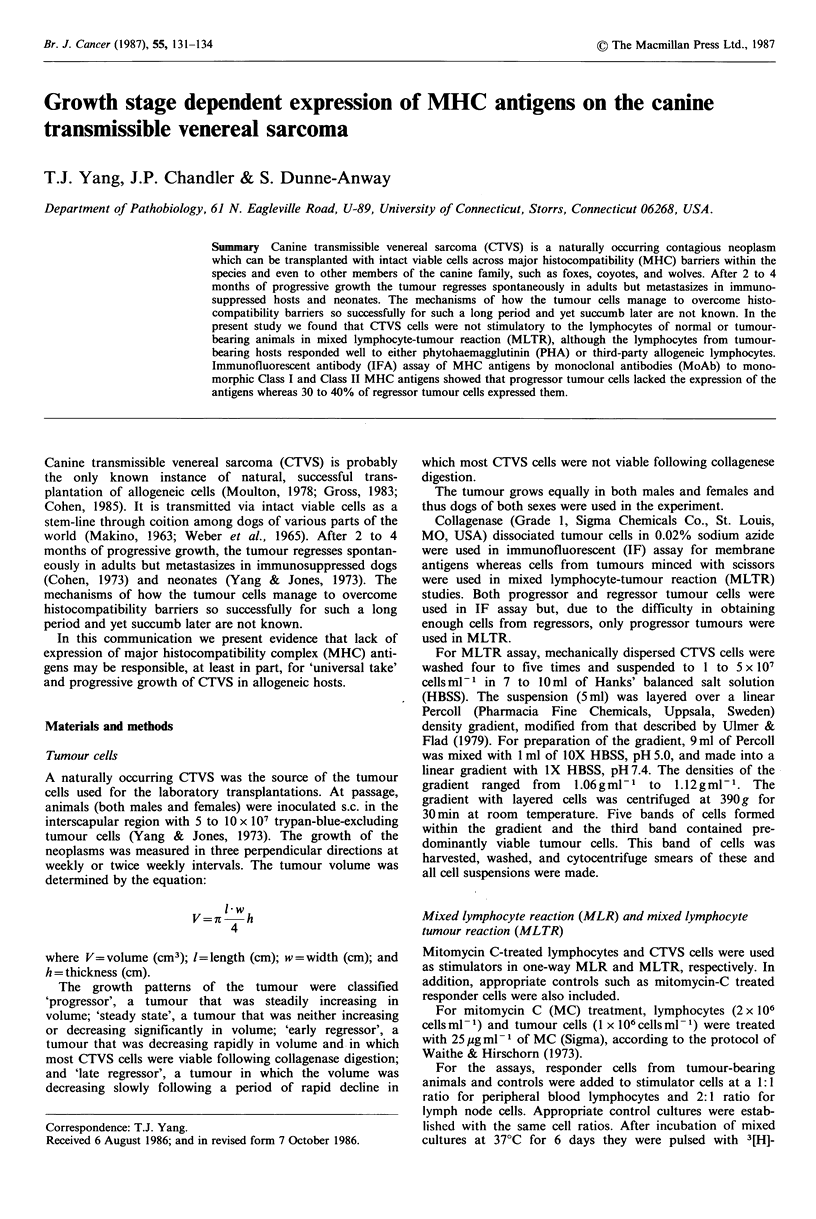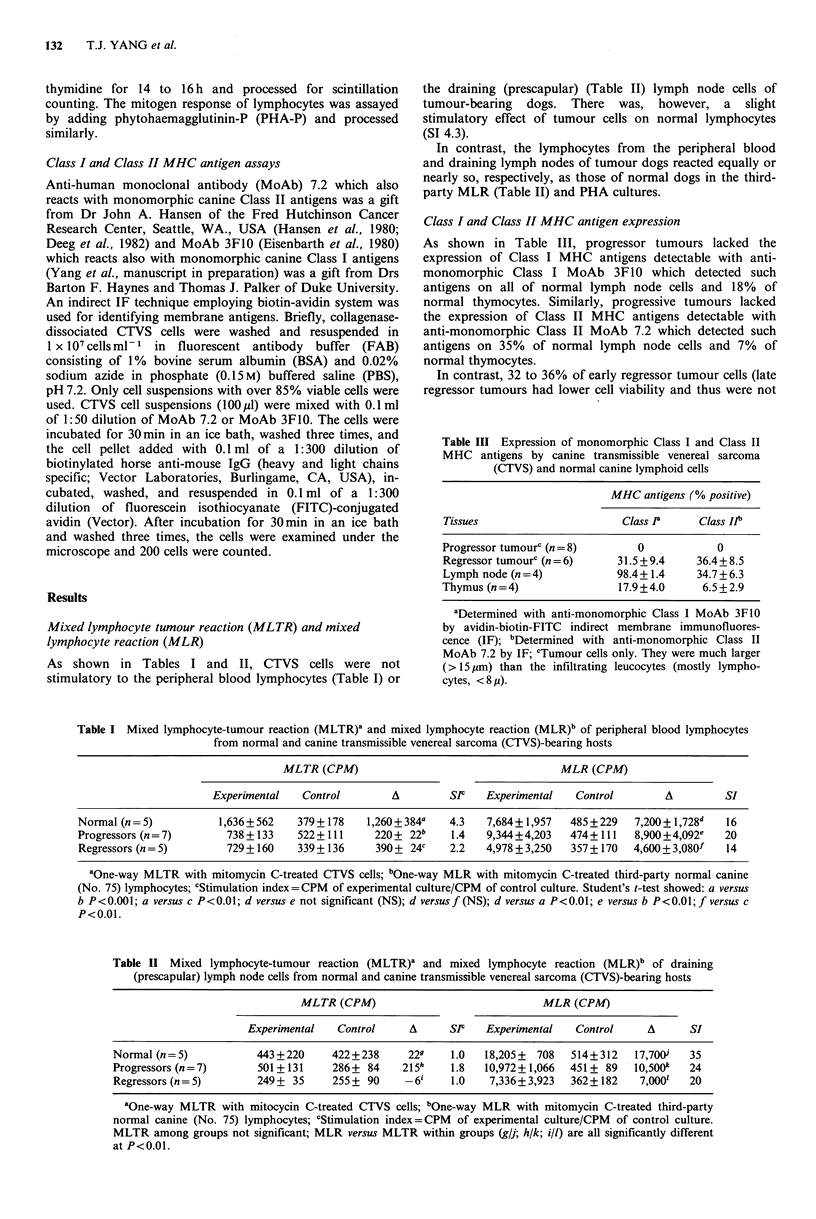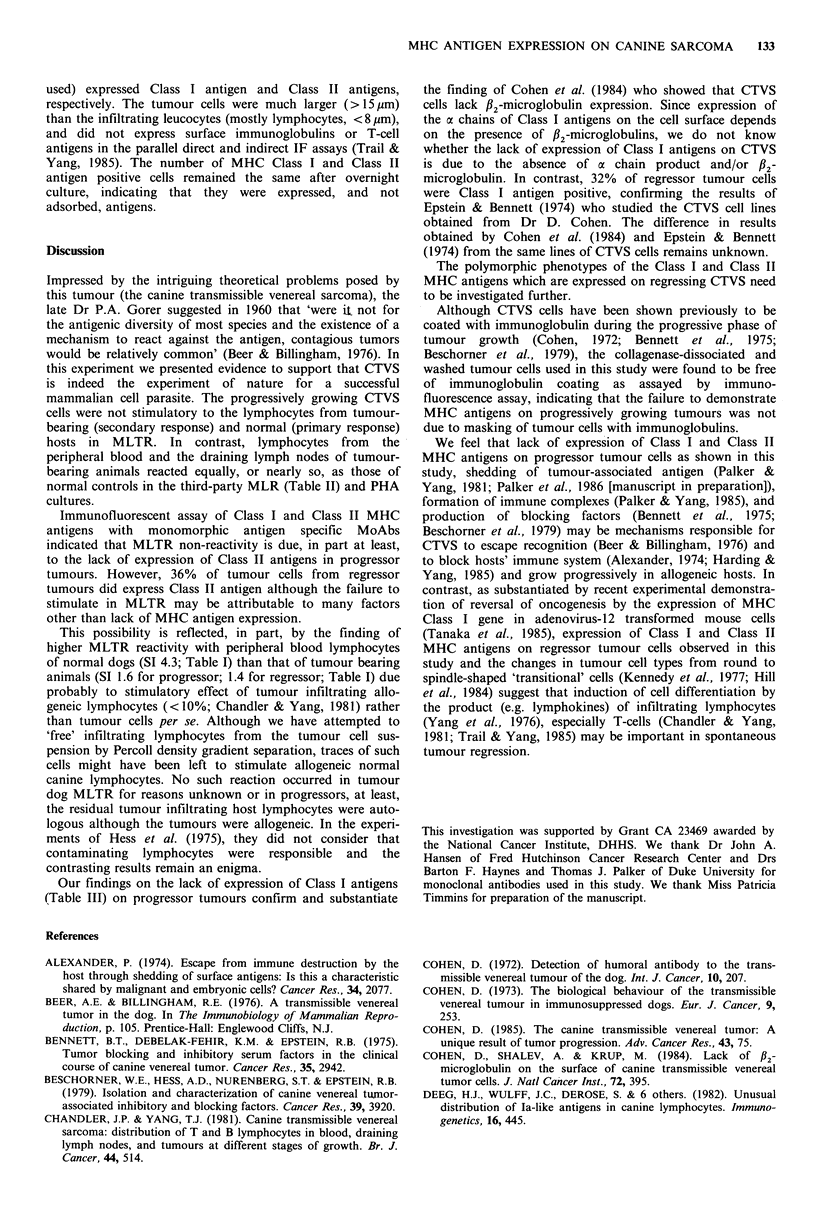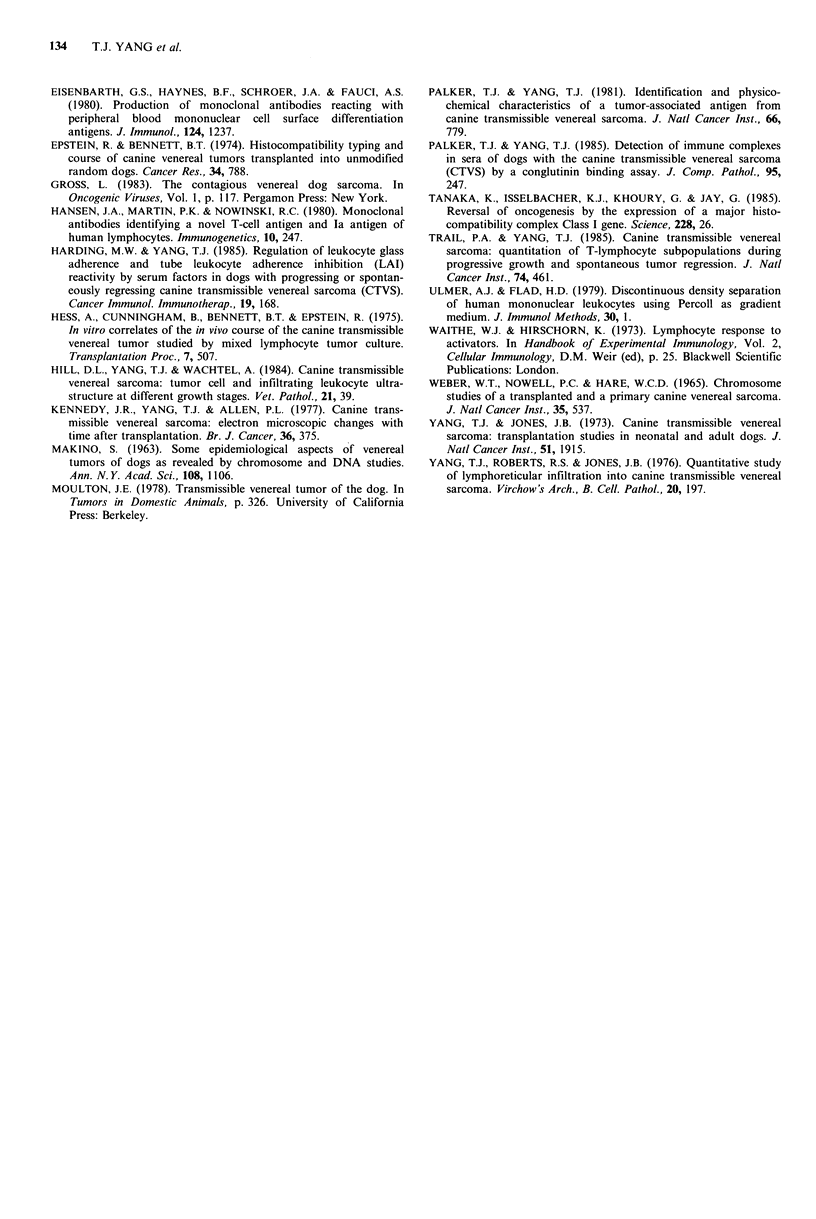Abstract
Canine transmissible venereal sarcoma (CTVS) is a naturally occurring contagious neoplasm which can be transplanted with intact viable cells across major histocompatibility (MHC) barriers within the species and even to other members of the canine family, such as foxes, coyotes, and wolves. After 2 to 4 months of progressive growth the tumour regresses spontaneously in adults but metastasizes in immunosuppressed hosts and neonates. The mechanisms of how the tumour cells manage to overcome histocompatibility barriers so successfully for such a long period and yet succumb later are not known. In the present study we found that CTVS cells were not stimulatory to the lymphocytes of normal or tumour-bearing animals in mixed lymphocyte-tumour reaction (MLTR), although the lymphocytes from tumour-bearing animals in mixed lymphocyte-tumour reaction (MLTR), although the lymphocytes from tumour-bearing hosts responded well to either phytohaemagglutinin (PHA) or third-party allogeneic lymphocytes. Immunofluorescent antibody (IFA) assay of MHC antigens by monoclonal antibodies (MoAb) to monomorphic Class I and Class II MHC antigens showed that progressor tumour cells lacked the expression of the antigens whereas 30 to 40% of regressor tumour cells expressed them.
Full text
PDF



Selected References
These references are in PubMed. This may not be the complete list of references from this article.
- Alexander P. Proceedings: Escape from immune destruction by the host through shedding of surface antigens: is this a characteristic shared by malignant and embryonic cells? Cancer Res. 1974 Aug;34(8):2077–2082. [PubMed] [Google Scholar]
- Bennett B. T., Debelak-Fehir K. M., Epstein R. B. Tumor-blocking and -inhibitory serum factors in the clinical course of canine venereal tumor. Cancer Res. 1975 Nov;35(11 Pt 1):2942–2947. [PubMed] [Google Scholar]
- Beschorner W. E., Hess A. D., Nerenberg S. T., Epstein R. B. Isolation and characterization of canine venereal tumor-associated inhibitory and blocking factors. Cancer Res. 1979 Oct;39(10):3920–3927. [PubMed] [Google Scholar]
- Chandler J. P., Yang T. J. Canine transmissible venereal sarcoma: distribution of T and B lymphocytes in blood, draining lymph nodes and tumours at different stages of growth. Br J Cancer. 1981 Oct;44(4):514–521. doi: 10.1038/bjc.1981.220. [DOI] [PMC free article] [PubMed] [Google Scholar]
- Cohen D. Detection of humoral antibody to the transmissible venereal tumour of the dog. Int J Cancer. 1972 Jul 15;10(1):207–212. doi: 10.1002/ijc.2910100126. [DOI] [PubMed] [Google Scholar]
- Cohen D., Shalev A., Krup M. Lack of beta 2-microglobulin on the surface of canine transmissible venereal tumor cells. J Natl Cancer Inst. 1984 Feb;72(2):395–401. [PubMed] [Google Scholar]
- Cohen D. The biological behaviour of the transmissible venereal tumour in immunosuppressed dogs. Eur J Cancer. 1973 Apr;9(4):253–258. doi: 10.1016/0014-2964(73)90090-x. [DOI] [PubMed] [Google Scholar]
- Cohen D. The canine transmissible venereal tumor: a unique result of tumor progression. Adv Cancer Res. 1985;43:75–112. doi: 10.1016/s0065-230x(08)60943-4. [DOI] [PubMed] [Google Scholar]
- Deeg H. J., Wulff J. C., DeRose S., Sale G. E., Braun M., Brown M. A., Springmeyer S. C., Martin P. J., Storb R. Unusual distribution of Ia-like antigens on canine lymphocytes. Immunogenetics. 1982;16(5):445–457. doi: 10.1007/BF00372103. [DOI] [PubMed] [Google Scholar]
- Eisenbarth G. S., Haynes B. F., Schroer J. A., Fauci A. S. Production of monoclonal antibodies reacting with peripheral blood mononuclear cell surface differentiation antigens. J Immunol. 1980 Mar;124(3):1237–1244. [PubMed] [Google Scholar]
- Epstein R. B., Bennett B. T. Histocompatibility typing and course of canine venereal tumors transplanted into unmodified random dogs. Cancer Res. 1974 Apr;34(4):788–793. [PubMed] [Google Scholar]
- Harding M. W., Yang T. J. Regulation of leukocyte glass adherence and tube leukocyte adherence inhibition (LAI) reactivity by serum factors in dogs with progressing or spontaneously regressing canine transmissible venereal sarcoma (CTVS). Cancer Immunol Immunother. 1985;19(3):168–176. doi: 10.1007/BF00199222. [DOI] [PMC free article] [PubMed] [Google Scholar]
- Hess A., Cunningham B., Taylor Bennett B., Epstein R. In vitro correlates of the in vivo course of the canine transmissible venereal tumor studied by mixed lymphocyte-tumor cultures. Transplant Proc. 1975 Dec;7(4):507–511. [PubMed] [Google Scholar]
- Hill D. L., Yang T. J., Wachtel A. Canine transmissible venereal sarcoma: tumor cell and infiltrating leukocyte ultrastructure at different growth stages. Vet Pathol. 1984 Jan;21(1):39–45. doi: 10.1177/030098588402100107. [DOI] [PubMed] [Google Scholar]
- Kennedy J. R., Yang T. J., Allen P. L. Canine transmissible venereal sarcoma: electron microscopic changes with time after transplantation. Br J Cancer. 1977 Sep;36(3):375–385. doi: 10.1038/bjc.1977.203. [DOI] [PMC free article] [PubMed] [Google Scholar]
- MAKINO S. SOME EPIDEMIOLOGIC ASPECTS OF VENEREAL TUMORS OF DOGS AS REVEALED BY CHROMOSOME AND DNA STUDIES. Ann N Y Acad Sci. 1963 Nov 4;108:1106–1122. doi: 10.1111/j.1749-6632.1963.tb13438.x. [DOI] [PubMed] [Google Scholar]
- Palker T. J., Yang T. J. Detection of immune complexes in sera of dogs with canine transmissible venereal sarcoma (CTVS) by a conglutinin-binding assay. J Comp Pathol. 1985 Apr;95(2):247–258. doi: 10.1016/0021-9975(85)90011-8. [DOI] [PubMed] [Google Scholar]
- Palker T. J., Yang T. J. Identification and physicochemical characterization of a tumor-associated antigen from canine transmissible venereal sarcoma. J Natl Cancer Inst. 1981 Apr;66(4):779–787. [PubMed] [Google Scholar]
- Tanaka K., Isselbacher K. J., Khoury G., Jay G. Reversal of oncogenesis by the expression of a major histocompatibility complex class I gene. Science. 1985 Apr 5;228(4695):26–30. doi: 10.1126/science.3975631. [DOI] [PubMed] [Google Scholar]
- Trail P. A., Yang T. J. Canine transmissible venereal sarcoma: quantitation of T-lymphocyte subpopulations during progressive growth and spontaneous tumor regression. J Natl Cancer Inst. 1985 Feb;74(2):461–467. [PubMed] [Google Scholar]
- Ulmer A. J., Flad H. D. Discontinuous density gradient separation of human mononuclear leucocytes using Percoll as gradient medium. J Immunol Methods. 1979;30(1):1–10. doi: 10.1016/0022-1759(79)90268-0. [DOI] [PubMed] [Google Scholar]
- Weber W. T., Nowell P. C., Hare W. C. Chromosome studies of a transplanted and a primary canine venereal sarcoma. J Natl Cancer Inst. 1965 Sep;35(3):537–547. doi: 10.1093/jnci/35.3.537. [DOI] [PubMed] [Google Scholar]
- Yang T. J., Jones J. B. Canine transmissible venereal sarcoma: transplantation studies in neonatal and adult dogs. J Natl Cancer Inst. 1973 Dec;51(6):1915–1918. doi: 10.1093/jnci/51.6.1915. [DOI] [PubMed] [Google Scholar]
- Yang T. J., Roberts R. S., Jones J. B. Quantitative study of lymphoreticular infiltration into canine transmissible venereal sarcoma. Virchows Arch B Cell Pathol. 1976 Apr 29;20(3):197–204. doi: 10.1007/BF02890339. [DOI] [PubMed] [Google Scholar]


